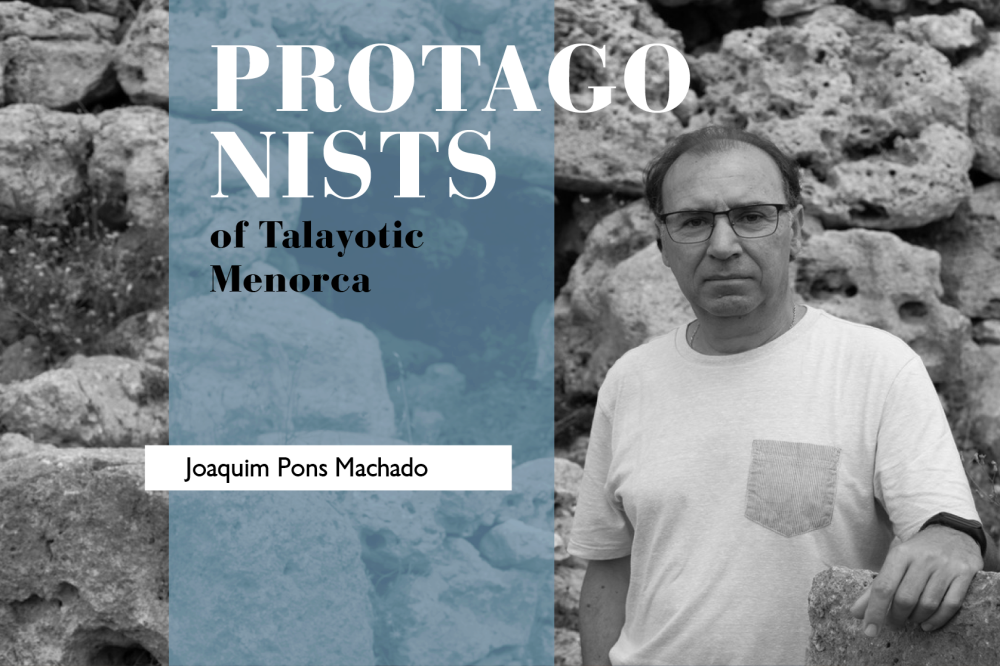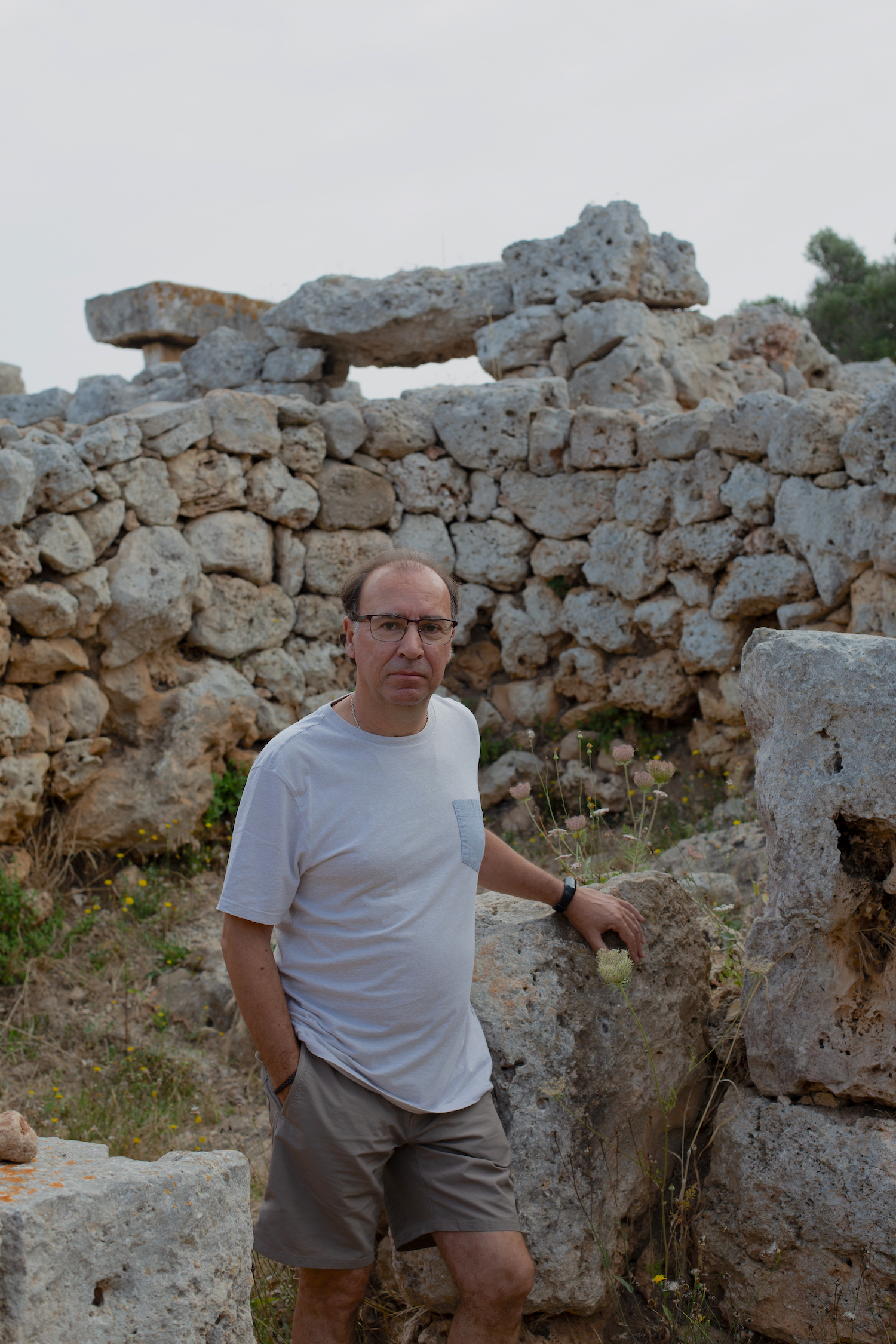 Joaquim Pons Machado holds a degree in History from the University of Barcelona and a PhD in Prehistoric Archaeology from the Autonomous University of Barcelona with the thesis "Characterisation of the space of the protohistoric habitat on the island of Menorca: the circular talayotic houses". With an extensive career as a researcher in the field, among others, he has directed and coordinated the archaeological work camps of the Associació Amics del Museu de Menorca at the site of Torrre d'en Galmés (Alaior), an entity of which he has been the secretary since 2005.
Joaquim Pons Machado holds a degree in History from the University of Barcelona and a PhD in Prehistoric Archaeology from the Autonomous University of Barcelona with the thesis "Characterisation of the space of the protohistoric habitat on the island of Menorca: the circular talayotic houses". With an extensive career as a researcher in the field, among others, he has directed and coordinated the archaeological work camps of the Associació Amics del Museu de Menorca at the site of Torrre d'en Galmés (Alaior), an entity of which he has been the secretary since 2005.
From 2019 to the beginning of 2023 he has been the technician of Talayotic Menorca in the Consell Insular de Menorca, being one of those responsible for the new candidacy dossier that has recently received the endorsement of ICOMOS.
How did your interest in archaeology begin?
Through the family circle. When we were young, my father used to take us on walks around Menorca and one of the places we used to visit were the archaeological sites. This aroused the interest in archaeology of both my brother, Octavi Pons, and myself. And to complete the picture, my wife, Carmen Lara, is also an archaeologist. Therefore, it has been an interest that has come from various sides and at different times that has led me to devote myself to archaeology.
And what made you decide to study the Talayotic culture?
Proximity, as it is the prehistoric culture that exists on the island. Despite having lived for some years in Catalonia and having participated in some projects there, I always maintained a link with my work in Menorca, and when it was time to plan both my third cycle work and my doctoral thesis, I had no doubt that they would be about Menorca. Thus, my dissertation was on the excavation we did with Amics del Museu de Menorca in Talatí de Dalt, and the doctoral thesis was on the circular Talayotic houses, structures that we excavated in Torre d'en Galmés.
In your career as a researcher, what are the projects that have had the greatest impact on you?
Without a doubt, the two I mentioned a moment ago. Although I had already participated in some other excavations before, such as the Trebalúger talayot, the Talatí de Dalt excavation was very important for me, as it was the first time I took part in a programmed excavation and all the work associated with it. Moreover, the last campaign we carried out there was the first time I directed an archaeological excavation. With all the subsequent work we were able to put on a small exhibition at the Museu de Menorca, publish a book on the excavation (together with Gustau Juan) and it helped me to do my third cycle project for my Master's degree in Prehistoric Archaeology.
The other project was the excavation of the Talayotic circles of Torre d'en Galmés that we did with the Associació d’Amics del Museu de Menorca. We were able to excavate two houses and also a couple of front courtyards, and all this work served as the basis for my doctoral thesis on the final Talayotic houses.
And which of the projects that are currently underway arouse your interest the most?
It is difficult for me to choose a specific one, as I think that this is a very interesting moment in Menorca's archaeology. Because of the continuity with the work I did, the Amics del Museu project in the northern area of Torre d'en Galmés seems very interesting to me, as it seeks to document the early Talayotic habitat. But also all the work of Boston University with the documentation of the Islamic occupation is providing a lot of information on how this use was developed and organised.
Other projects worth mentioning are those of Cornia Nou and Sant Agustí, with all the information they are providing on the early Talayotic world, the navetas of Cala Morell with the documentation of the naviform habitat, sa Mitja Lluna on prehistoric mining, the study of the taulas with the excavation of Sa Cudia Cremada...
As I said, it is a very interesting time with many open lines that will surely provide a lot of information to improve our knowledge of Menorca's prehistory.
 Both because of your work as an archaeologist and your role as a Talayotic Menorca technician, your career has been closely linked to the candidacy. Now that ICOMOS has given the green light, what is your assessment of this period?
Both because of your work as an archaeologist and your role as a Talayotic Menorca technician, your career has been closely linked to the candidacy. Now that ICOMOS has given the green light, what is your assessment of this period?
It is a very positive balance, both personally and professionally. The fact of being able to work on a project like Talayotic Menorca, with the aim of achieving its inscription on the World Heritage List, is a privilege. It is a unique occasion, as it will be very difficult to submit any other Menorcan heritage site to UNESCO.
From a personal point of view, it has been another key project, along with the two I have already mentioned. As I said, it is a privilege to have been able to work on the candidacy and to be able to do so with all the people who have participated. Working with someone like Cipriano Marín has been a luxury from whom I have been able to learn a lot. But it has also been a privilege to work with many people who have been involved in the project. The list is very long, as can be seen in the acknowledgements of the dossier, and many of them have been interviewed before me in this section of Protagonists.
Therefore, I am very satisfied with this stage since the main objective has been achieved, which is the inscription of Talayotic Menorca on the World Heritage List, and I am very happy for all that it has given me on a personal level.
Bearing in mind that you are an important actor in the elaboration of this new dossier, what was the whole process of reconstructing the candidacy like?
It was a complex process. Initially, it is worth highlighting the work carried out by Antoni Ferrer, at that time the island's director of Cultural Affairs and Heritage, together with the incorporation of Cipriano Marín in the role of coordinator. They made the initial proposal of the components of Talayotic Menorca.
I joined the project in May 2019, when this initial proposal was put on the table. From that moment on, the work of discussion with the collaborators of the candidacy began in order to adjust this proposal to criteria that were more realistic and that could be accepted by ICOMOS and UNESCO.
The work was intense, as trying to combine heritage and landscape, as requested in the 2017 ICOMOS report, was not easy. But, fortunately, we had the support of great collaborators who helped us in this process to link the discourse and the approach that can be seen in the Talayotic Menorca dossier.
Despite being clearly positive, the ICOMOS report also points out some recommendations to be implemented. What do you think should be the priorities from now on?
As the conseller of Cultural Affairs Miquel Àngel Maria has already repeated in the presentations we made of the Talayotic Menorca documentary, inscription on the World Heritage List is not the end of the road. Quite the contrary, it is just a point and a break and the real work with Menorca Talayotic begins now. We have put the instruments on the table, the Talayotic Menorca Agency and its management plan, so that from now on they can begin to be developed.
One of our priorities is the development of heritage custody contracts. This is one of the key tools of the management plan and through which the Talayotic Menorca Agency must establish the framework for relations with the owners and managers of the properties included in the World Heritage declaration.
The monitoring of the property is also a very important point. UNESCO periodically requests reports on the state of World Heritage properties, so the structure for collecting information must be created to comply with these requests.
And we must be clear that the inscription of Talayotic Menorca on the World Heritage List is a commitment to the future. It is Menorca's commitment to the rest of the world to conserve its prehistoric heritage so that it can be passed on to future generations in at least the same state as it is in today. And as far as possible, to improve it and broaden our knowledge of it.
The Menorca Talayotic Agency is key to the future of the candidacy, beyond the probable nomination as a World Heritage site. What role should it play?
Its role is key. I have already mentioned in the previous question some of the challenges it faces beforehand. But as you can see from the management plan, they go far beyond the few things I have said. The role of the agency will be crucial, as it is the body that has to develop this document, which is just its roadmap for the future.
Therefore, the Agency, under the direction of Antoni Ferrer, faces the challenge of developing this management plan so that Talayotic Menorca can be a real and useful instrument. Menorca's archaeological heritage is impressive, both in terms of quantity and quality, and Talayotic Menorca should be its ambassador to the world through this World Heritage declaration.
There is a sector of people who are interested in cultural heritage and who are attentive to UNESCO and its list, so Menorca will be taken more into account as a cultural destination. Thus, the role of the agency, among other aspects, will be to ensure that the expectations created are rewarded when these visitors come to Menorca.
But it must also work on the involvement of the local population. This has to do both with the knowledge that the people of the island may have about world heritage, which will have an impact on its respect and conservation, and with the possibilities that open up in relation to the cultural industry.
Well, we could go on, because as I said, I believe that the role of the agency is fundamental for the future and we hope that it can be fully developed in order to achieve the objectives set out in the management plan.